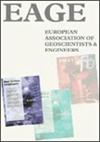利用地面穿透雷达对中国现代黄河三角洲的土壤层进行调查
IF 1.6
4区 地球科学
Q3 GEOCHEMISTRY & GEOPHYSICS
引用次数: 0
摘要
土层会影响水分和盐分的垂直移动,最终导致土地覆盖和土地利用模式的变化。本研究探讨了地面穿透雷达(GPR)探测中国现代黄河三角洲土壤层的能力,并评估了其准确性。研究发现,土壤水分和盐分对电磁波信号有很强的阻尼作用,导致 1 米以下土壤剖面的 GPR 图像模糊不清。为了估算单个土层的厚度,利用土壤质量含水量计算了电磁波的传播速度,并通过比较 GPR 图像和土壤剖面的振幅-时间图确认了传播时间。估算厚度是实地测定厚度的 1.02 倍,平均估算误差为 0.04 米,是实地测定土层厚度的 24.09%。包络振幅能量随时间的二次导数值(SDEA)用于描述土层的振幅变化。SDEA 与土壤质量含水量和导电率分别存在负对数和幂函数关系。本研究结果为今后使用 GPR 对沉积平原地区的土壤进行定量调查提供了参考数据库。本文章由计算机程序翻译,如有差异,请以英文原文为准。
Investigating soil layers with ground penetrating radar in the modern Yellow River Delta of China
Soil layers affect the vertical movement of moisture and salt, eventually resulting in land cover and land use pattern changes. This study explored the ability of ground penetrating radar (GPR) to detect soil layers in the modern Yellow River Delta of China and assessed its accuracy. It was found that soil moisture and salt had a strong dampening effect on the electromagnetic wave signal which resulted in blurred GPR images of the soil profile below 1 m. The cultivated soil layers of different crop types such as rice, wheat, corn, and cotton were accurately identified in GPR images. To estimate an individual soil layer thickness, the propagation velocity of the electromagnetic wave was calculated using soil mass moisture content, and the propagation time was confirmed by comparing the GPR image with the amplitude-time plot of the soil profile. The estimated thickness was 1.02 times the thickness determined in the field and the average estimation error was 0.04 m, which was 24.09% of the soil layer thickness determined in the field. The second derivative value of envelope amplitude energy with time (SDEA) was used to describe the amplitude change in the soil layers. The SDEA has negative logarithmic and power function relationships with soil mass moisture content and electrical conductivity, respectively. The present results provide a reference database for future quantitative soil investigation in the sedimentary plain area using GPR.
求助全文
通过发布文献求助,成功后即可免费获取论文全文。
去求助
来源期刊

Near Surface Geophysics
地学-地球化学与地球物理
CiteScore
3.60
自引率
12.50%
发文量
42
审稿时长
6-12 weeks
期刊介绍:
Near Surface Geophysics is an international journal for the publication of research and development in geophysics applied to near surface. It places emphasis on geological, hydrogeological, geotechnical, environmental, engineering, mining, archaeological, agricultural and other applications of geophysics as well as physical soil and rock properties. Geophysical and geoscientific case histories with innovative use of geophysical techniques are welcome, which may include improvements on instrumentation, measurements, data acquisition and processing, modelling, inversion, interpretation, project management and multidisciplinary use. The papers should also be understandable to those who use geophysical data but are not necessarily geophysicists.
 求助内容:
求助内容: 应助结果提醒方式:
应助结果提醒方式:


